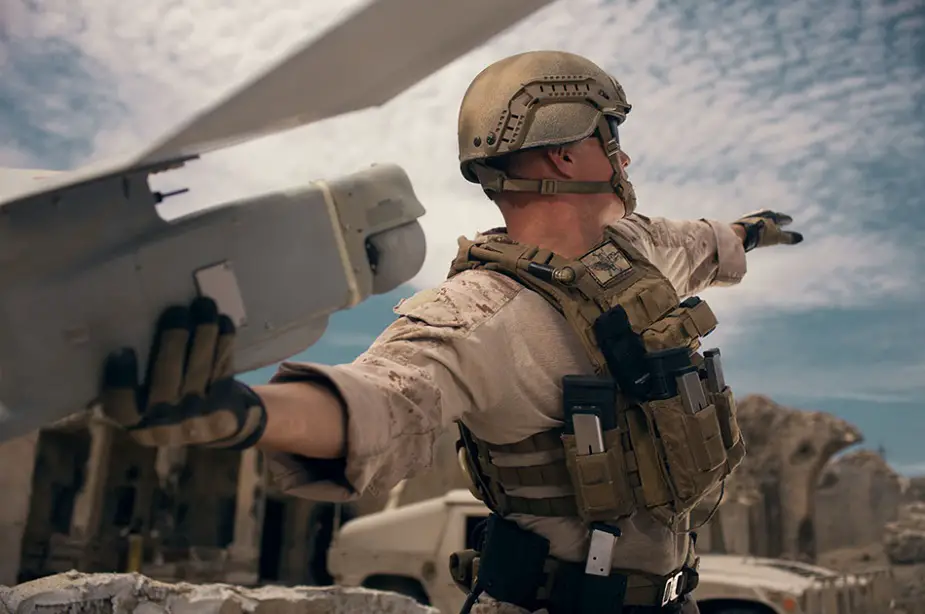US military wants to develop a suite of compact multi-weapon system payloads that deliver scalable Intermediate Force Capability (IFC) effects combined with other military effects for: applicability and effectiveness in multiple domains; synergistic value of integrating the various IFC effects with other multi-use military capabilities in a common architecture, such as Command, Control, Communications, Computers, Intelligence, Surveillance, and Reconnaissance (C4ISR); secure communications; and automated fire control systems, all integrated aboard small manned and unmanned systems (UxS) platforms. Platforms include small tactical vehicles/vessels and unmanned ground vehicles (UGVs) for both urban and austere terrains, unmanned aerial vehicles (UAVs) for both counter-air and ground support operations, unmanned surface vehicles (USVs) for both the littorals and open water operations, and unmanned underwater vehicles (UUVs).
Follow Air Recognition on Google News at this link
 Raven B UAS (Picture source: AeroVironment)
Raven B UAS (Picture source: AeroVironment)
This Small Business Innovation Research (SBIR) topic seeks to develop a suite of more compact and lightweight long range non-lethal counter-personnel and counter-materiel payloads for integration on small tactical vehicles/platforms and UxS. These IFC payloads will support a variety of stabilization operations, gray zone warfare, and regular and irregular warfare missions across the full Range of Military Operations (ROMO).
These non-lethal (NL)/IFC payloads with enhanced system performance seek to mitigate codified joint non-lethal weapon capability-gaps. There is Service transition interest in these NL/IFC payloads in both the Maritime (U.S. Navy and U.S. Coast Guard) and Ground (U.S. Army and USMC) domains as each Service currently desires IFCs via small/lightweight low-cost systems that can project/provide long-range IFCs. These desired effects across the full breadth of the ROMO must be accomplished with integration of these small NL/IFC payloads on tactical manned and unmanned platforms with significant reduced overall system size, weight, power consumption, thermal cooling (-55 degrees C to 125 degrees C) and lower system costs (SWAP/C2) .
Existing IFCs have known range and overall system size and weight limitations, i.e., the current COTS solutions only mitigate a very small portion of the codified Joint Requirements Oversight Council (JROC) approved counter-personnel and counter-materiel capability-gap. This topic supports future long range compact and lightweight IFC to provide long range hail and warn, non-lethal counter-personnel tasks: such as deny access, move, suppress, and disable individuals and non-lethal counter-materiel tasks: such as stop/disable vehicles, vessels and aircraft.
These new innovative compact/lightweight IFC payloads include existing, both commercial off the shelf (COTS) and developmental, NL weapon technologies/stimuli such as: dazzling lasers, 12 gauge/40mm non-lethal munitions (blunt impact, flashbang, riot control agents, human electro-muscular incapacitation, malodorant) with associated munition launching/targeting and fire control systems; long range acoustic hailing devices, and directed energy (DE) weapons such as counter-electronics (e.g., high power microwave weapons) and Active Denial Technologies (ADT).
These new innovative payloads shall also include new/novel non-lethal payloads with innovative human effects and new non-lethal stimuli such as optogenics modulation of high magnetic fields and other new non-lethal stimuli that provide long range IFCs such as: long range hail and warn capabilities; area denial – deny access capabilities; human target suppression; ability to move individuals and/or groups of individuals from open and confined spaces; and (5) ability to non-lethally incapacitate/disable threat human/material targets.
















